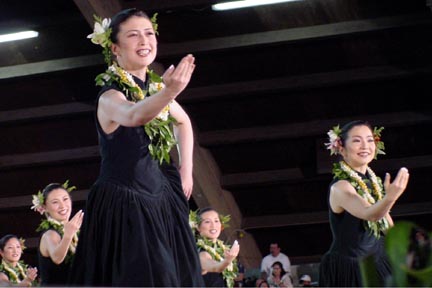
ASSOCIATED PRESS
Hula dancers from Puanani Takahashi Hula Studio, from Tokyo, performed last week during an exhibition at the Merrie Monarch Hula Festival in Hilo.
Japanese flock to
Merrie Monarch festHula boasts more than 100 schools
in Japan, where the industry
makes millions
HILO » Hula dancer Hisayo Shimizu did not compete in Hawaii's most prestigious hula festival, but she was just about as excited to be at the Merrie Monarch Festival as anyone at the competition.
The Tokyo dentist and hundreds of other Japanese visitors came to the 40-year-old festival, the focal point of a tradition that an estimated 300,000 Japanese have embraced.
Every child in Hawaii is exposed to the hula, with its mix of rich spiritual tradition and connection with nature, and many make it part of their lives. But with the island dance's popularity in a nation whose population is 100 times that of Hawaii's 1.2 million people, there might be more people dancing hula in Japan than in the islands where the dance was born.
Several hundred dancers from Japanese halau, or hula schools, came to the Big Island to watch the annual contest that showcases the native dance.
Shimizu lived in Hawaii for four years while attending Chaminade University, and developed an appreciation for the hula dancers she saw.
Returning to Japan, she joined Halau Nalei Lehua i Kauanoe in Tokyo, where she has been dancing for three years.
"I love it. It's so beautiful," Shimizu said. "When I dance I feel something from nature. I feel the mana (spiritual power) of Hawaii."
Hula is a multimillion-dollar enterprise in Japan. More than 100 hula schools operate in Japan, according to Yasunari Ishimura, a Japanese publisher and producer who also promotes hula programs there, including one similar to Hawaii's Merrie Monarch Festival.
Several quarterly publications extoll the native Hawaiian dance form and other aspects of Hawaiian culture. The nearly 200-page slick, full-color journals include feature stories on Hawaii kumu hula, how-to articles on making floral leis, and other topics of interest to hula dancers, as well as dozens of advertisements for hula halau, Hawaiian festivals and Hawaiian clothing, jewelry and food products.
In Japan most hula dancers are women, but a few men are starting to train as well, said Tamaki Takahashi, of Tokyo, a freelance writer and hula dancer. Takahashi said the magazine she writes for, Attractive Hula Style, has a circulation of about 80,000.
"Hula in Japan is big business," said Hawaii kumu Coline Aiu, adding that her mother, the late kumu Maiki Aiu Lake, was the first to teach in Japan.
One of Lake's first Japanese students was Kimie Ozaki, who came to Hawaii in the early 1970s, said Aiu.
"Maiki encouraged her to share her talent with other women in Japan," she said.
Two of Ozaki's students were twin sisters Mariko and Kumiko Honda, who came to Hawaii and spent six months studying with Lake.
Lake had just returned from a trip to Japan to help the twin sisters present a hula concert shortly before she died in 1984, Aiu said.
"Hula is the only dance that allows anyone of any shape, ethnicity or any ability to participate," Aiu said. "It encompasses all and invites them to participate -- just like our culture."
Takahashi agreed, saying that 10 years ago it was mostly older women doing the hula "because it is not too difficult physically."
Now, she said, women in their 20s and 30s, and a few men, are doing hula -- and not just the more graceful auana, or modern hula, but the more physical kahiko, or ancient style.
"Japanese people are very busy and life is hectic," Takahashi said in explaining the popularity of hula in Japan. "In hula they can forget the stress."
Both Shimizu and Takahashi said Japanese women also are attracted to hula because of the lure of island culture and the beautiful dresses they can wear while dancing.
"While the Japanese dance well, it is important that they understand the culture," Aiu said.
Takahashi said the dance draws many Japanese fans to a growing interest in Hawaiian culture and history. She comes to Hawaii four or five times a year to study with a Hawaiian kumu.
"In learning from a Hawaiian kumu, you learn not only the dances, but the language and culture and the background of the songs and dances," she said.
And at least one Hawaii kumu says she stresses the culture in teaching Japanese students.
Noelani Chang, kumu of Na Mamo o Kaala in Waianae, began working with two schools in Japan last September. Since returning to Hawaii, she has critiqued dancers in the two groups via videotape.
Chang's halau performed with the two Japanese halau -- Halau Nalei Lehua i Kauanoe, of Tokyo, and Puanani Takahashi Hula Studio, of Yokohama -- during a Merrie Monarch exhibition Wednesday night before a crowd of about 2,500.
It was the first time Japanese halau had performed with a Hawaii halau at the festival, Ishimura said.
Chang said, however, she does not foresee Japanese halau competing at Merrie Monarch.
— ADVERTISEMENTS —
— ADVERTISEMENTS —
